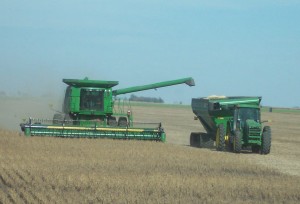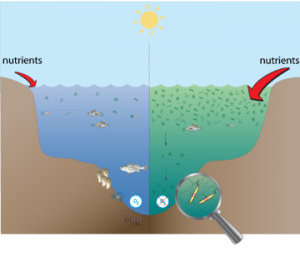Little additional land has been converted to cropland since the 1950’s, but a recent study reports that changes in its use could pave the way for more dead zones in the Great Lakes.

High intensity agriculture leads to increased use of fertilizer which pollutes surface waters. Image: USDA
These zones have too little oxygen to support fish and some plants.
“More cropland is used for annual crops like corn and soybeans and less for natural, more permanent plants such as hayfields and pasture,” said Tim Meehan an entomologist at the University of Wisconsin-Madison and lead researcher in a study looking at the effects of landscape changes on the environment. “This agriculture intensification has brought loss of natural habitats and increased use of pesticides, fertilizer and manure which pollute the lakes.”
Once again Lake Erie is a casualty.
The dead zone in the central basin of the lake has grown up to two thirds of the entire lake in recent years, said Donald Scavia, a water resource professor at the University of Michigan and an expert on dead zones.
Scavia is leading a study to establish the link between climate change, farming and dead zones. The idea is to help farmers modify their practices to control their impacts on the lakes.
Algae occur naturally in water. But phosphorous and nitrates from farm fertilizers and manure, combined with increasing temperatures, stimulate excessive growth, he said.
Large blooms deplete oxygen in the water and sometimes replace nutritious algae with harmful or inedible species. That can lead to a massive fish kill, studies show. Decaying algae at the bottom of the lakes also use up the oxygen needed by other water organisms.
Increasing temperatures + Increasing farm run-offs = Algal blooms in the Great Lakes

In a balanced ecosystem (left) some nutrients fuel the growth of microscopic algae, which are the base of the aquatic food chain. In an unbalanced ecosystem (right), excess nutrients cause too many algae to grow. The excess algae die, sink to the bottom, and are decomposed by bacteria, which use up oxygen in the water. Image: google.com
Scavia and his team fear that increasing temperatures associated with climate change, accompanied by winter and spring storms which flush manure and fertilizers into the lakes, may mean algal blooms causing dead zones in other parts of the Great Lakes.
Especially vulnerable are shallow areas like Lake Huron’s Saginaw Bay, Wisconsin’s Green Bay and central Lake Erie
While mitigating the effects of climate change is a long-term effort, Scavia said amending the Farm Bill, a federal law that regulates agricultural practices, could help restore the lakes.
He said the bill needs to allocate more funds and work towards land and water conservation.
Some of the conservation efforts funded by the bill include training farmers and the public to:
- Determine and use just the right amount of fertilizer for crops.
- Determine when to apply fertilizer to reduce run-offs.
- Use buffer strips rather than farm fields
- Preserve and restore wetlands
- Use less productive lands for conservation
- Use planting methods that minimize soil erosion.
Whether such programs can be expanded is uncertain. They are more likely to suffer funding cuts than other programs, to said Stacy James, a water resources scientist with the Prairies Rivers Network in Illinois.
Her group supports updating the Farm Bill next year to require:
- All producers participating in existing or new crop and revenue insurance programs to meet conservation compliance standards.
- Vegetative buffer zones at least 35 feet wide between row crops and all lakes, rivers and smaller streams.
- Increasing inspections and
enforcement of conservation practices.
The Clean Water Act could also be used to reduce run-offs by regulating application of chemicals more stringently, James said. It should mandate record-keeping for fertilizer purchases and applications.
“It’s more effective to control the problem at the source than to allow farmers to continue externalizing the cost of farming to the general society in the form of degraded waters,” she said.
Editors note: Write thru at 5:35 8/12/2011 to correct name of lake.
We need to save Lake Erie and the other Great Lakes! Please ask your state representatives to support updating the Farm Bill.
Reminds me, David, of the old Bob Marley song, “One Lake.”
C’mon Jim, the hydrologists say that technically Michigan/Huron are all one lake.
Just kidding. Thanks for the heads up.
What if the “Farm Bill” was renamed the “Food Bill,” which a commentary by the Biodiversity Project says is a more appropriate descriptor?
Would that “rebranding” help get folks involved and improve agriculture’s environmental record?
Here’s the commentary.
http://biodiversityproject.org/docs/newsletters/Biodiversity%20Project_Winter%202011_newsletter.pdf
Quick disclosure – I’m board chair of Biodiversity Project.
Gary Wilson
“Especially vulnerable are shallow areas like Lake Michigan’s Saginaw Bay, Wisconsin’s Green Bay and central Lake Erie.”
Lake Michigan’s Saginaw Bay?